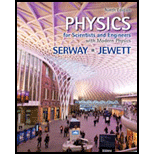
Review. A light spring of force constant 3.85 N/m is compressed by 8.00 cm and held between a 0.250-kg block on the left and a 0.500-kg block on the right. Both blocks are at rest on a horizontal surface. The blocks are released simultaneously so that the spring tends to push them apart. Find the maximum velocity each block attains if the coefficient of kinetic friction between each block and the surface is (a) 0, (b) 0.100, and (c) 0.462. Assume the coefficient of static friction is greater than the coefficient of kinetic friction in every case.
(a)
The maximum velocity of each block if the coefficient of kinetic friction between block and the surface is 0.
Answer to Problem 87AP
The maximum velocity of each block is
Explanation of Solution
Given info: The force constant is
Write the expression to calculate the force by the spring.
Here,
Substitute
Write the expression of conservation of energy.
Here,
Substitute
Write the expression of conservation of linear momentum.
Substitute
Substitute
Substitute
Thus, the maximum velocity of each block is
Conclusion:
Therefore, the maximum velocity of each block is
(b)
The maximum velocity of each block if the coefficient of kinetic friction between block and the surface is
Answer to Problem 87AP
The maximum velocity of each block is
Explanation of Solution
Given info: The force constant is
Write the expression to calculate the normal force on the lighter block.
Here,
Substitute
Write the expression to calculate the limiting frictional force.
Here,
Substitute
The spring force,
Since the mass of right block is double than the left block therefore the limiting force of friction is also two times the left one i.e.
The limiting frictional force of right clock is greater than the spring force so it will not move.
The left will continue to move as long as the spring force is large than the friction force.
Write the expression to calculate the limiting frictional force.
Here,
Substitute
Write the expression of conservation of energy.
Substitute
The negative sign indicates that the direction of motion of the lighter block is toward negative x axis.
The velocity of the heavier block is zero.
Thus, the maximum velocity of each block is
Conclusion:
Therefore, the maximum velocity of each block is
(c)
The maximum velocity of each block if the coefficient of kinetic friction between block and the surface is
Answer to Problem 87AP
The velocity of both blocks is 0.
Explanation of Solution
Given info: The force constant is
Write the expression to calculate the limiting frictional force of left block.
Substitute
Write the expression to calculate the limiting frictional force of right block.
Substitute
The spring force is less than the limiting frictional force of both the blocks so the blocks will not move.
Conclusion:
Therefore, the velocity of both blocks is 0.
Want to see more full solutions like this?
Chapter 9 Solutions
Physics for Scientists and Engineers With Modern Physics
- I need correct answer not chatgptarrow_forwardWhat is the resistance (in (2) of a 27.5 m long piece of 17 gauge copper wire having a 1.150 mm diameter? 0.445 ΧΩarrow_forwardFind the ratio of the diameter of silver to iron wire, if they have the same resistance per unit length (as they might in household wiring). d. Ag dFe = 2.47 ×arrow_forward
- Find the ratio of the diameter of silver to iron wire, if they have the same resistance per unit length (as they might in household wiring). d Ag = 2.51 dFe ×arrow_forwardShow that the units 1 v2/Q = 1 W, as implied by the equation P = V²/R. Starting with the equation P = V²/R, we can get an expression for a watt in terms of voltage and resistance. The units for voltage, V, are equivalent to [? v2 v2 A, are equivalent to J/C ✓ X . Therefore, 1 = 1 = 1 A V1 J/s Ω V-A X = 1 W. . The units for resistance, Q, are equivalent to ? The units for current,arrow_forwardPlease solve and answer the question correctly please. Thank you!!arrow_forward
 Physics for Scientists and Engineers, Technology ...PhysicsISBN:9781305116399Author:Raymond A. Serway, John W. JewettPublisher:Cengage Learning
Physics for Scientists and Engineers, Technology ...PhysicsISBN:9781305116399Author:Raymond A. Serway, John W. JewettPublisher:Cengage Learning Principles of Physics: A Calculus-Based TextPhysicsISBN:9781133104261Author:Raymond A. Serway, John W. JewettPublisher:Cengage Learning
Principles of Physics: A Calculus-Based TextPhysicsISBN:9781133104261Author:Raymond A. Serway, John W. JewettPublisher:Cengage Learning Physics for Scientists and Engineers: Foundations...PhysicsISBN:9781133939146Author:Katz, Debora M.Publisher:Cengage Learning
Physics for Scientists and Engineers: Foundations...PhysicsISBN:9781133939146Author:Katz, Debora M.Publisher:Cengage Learning Classical Dynamics of Particles and SystemsPhysicsISBN:9780534408961Author:Stephen T. Thornton, Jerry B. MarionPublisher:Cengage Learning
Classical Dynamics of Particles and SystemsPhysicsISBN:9780534408961Author:Stephen T. Thornton, Jerry B. MarionPublisher:Cengage Learning Physics for Scientists and Engineers with Modern ...PhysicsISBN:9781337553292Author:Raymond A. Serway, John W. JewettPublisher:Cengage Learning
Physics for Scientists and Engineers with Modern ...PhysicsISBN:9781337553292Author:Raymond A. Serway, John W. JewettPublisher:Cengage Learning Physics for Scientists and EngineersPhysicsISBN:9781337553278Author:Raymond A. Serway, John W. JewettPublisher:Cengage Learning
Physics for Scientists and EngineersPhysicsISBN:9781337553278Author:Raymond A. Serway, John W. JewettPublisher:Cengage Learning





